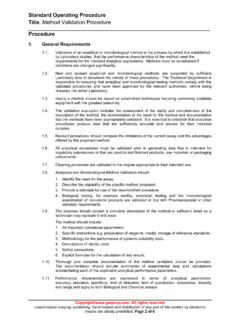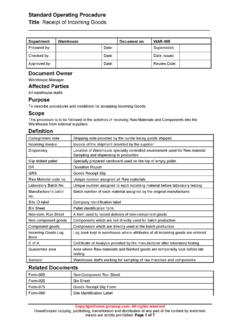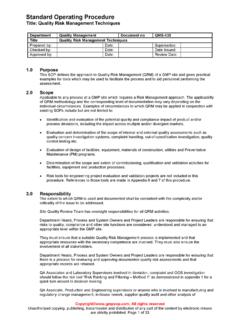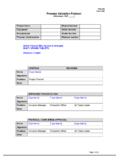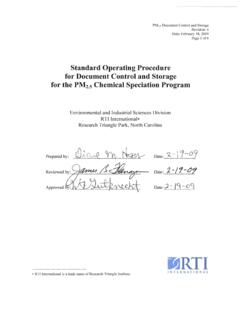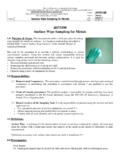Transcription of Standard Operating Procedure
1 Standard Operating Procedure Title: Quality Risk Management Techniques Department Quality Management Document no QMS-135. Title Quality Risk Management Techniques Prepared by: Date: Supersedes: Checked by: Date: Date Issued: Approved by: Date: Review Date: Purpose This SOP defines the approach to Quality Risk Management (QRM) of a GMP site and gives practical examples for tools which may be used to facilitate the process and to aid personnel performing the assessment. Scope Applicable to any process at a GMP site which requires a Risk Management approach. The applicability of QRM methodology and the corresponding level of documentation may vary depending on the individual circumstances. Examples of circumstances to which QRM may be applied in conjunction with existing sops include but are not limited to: Identification and evaluation of the potential quality and compliance impact of product and/or process deviations, including the impact across multiple and/or divergent markets.
2 Evaluation and determination of the scope of internal and external quality assessments such as quality concern investigation systems, complaint handling, out-of-specification investigation, quality control testing etc. Evaluation of design of facilities, equipment, materials of construction, utilities and Preventative Maintenance (PM) programs. Determination of the scope and extent of commissioning, qualification and validation activities for facilities, equipment and production processes. Risk tools for engineering project evaluation and validation projects are not included in this Procedure . References to those tools are made in Appendix 6 and 7 of this Procedure . Responsibility The extent to which QRM is used and documented shall be consistent with the complexity and/or criticality of the issue to be addressed. Site Quality Review Team has oversight responsibilities for all QRM activities.
3 Department Heads, Process and System Owners and Project Leaders are responsible for ensuring that risks to quality, compliance and other site functions are considered, understood and managed to an appropriate level within the GMP site. They must ensure that a suitable Quality Risk Management process is implemented and that appropriate resources with the necessary competence are involved. They must also ensure the involvement of all stakeholders. Department Heads, Process and System Owners and Project Leaders are responsible for ensuring that there is a process for reviewing and approving documented quality risk assessments and that appropriate records are retained. QA Associates and Laboratory Supervisors involved in deviation, complaint and OOS investigation should follow the risk tool Risk Ranking and Filtering Method 1 as demonstrated in appendix 1 for a quick turn around in decision making.
4 QA Associate, Production and Engineering supervisors or anyone who is involved in manufacturing and regulatory change management, in-house rework, supplier quality audit and other analysis of Copyright All rights reserved Unauthorized copying, publishing, transmission and distribution of any part of the content by electronic means are strictly prohibited. Page 1 of 33. Standard Operating Procedure Title: Quality Risk Management Techniques Initiating Quality Risk Management (QRM) Process Risks are multi-dimensional and a shared understanding is a prerequisite for the success of any risk management process. The initiation phase of the QRM process involves understanding the risk event by defining and agreeing the context, the scope and the tolerability criteria for the quality risk assessment, together with any underlying assumptions.
5 Initiation of QRM process should involve all the stakeholders. All the relevant information is assembled and shared, any gaps are identified and analysis tools are selected. The scope of the quality risk assessment must be clearly defined both in business and technical terms. The scope should clearly establish the boundaries of the process, system, project or activity being assessed and any inherent assumptions that are made. It should consider possible interactions outside the boundary and their potential impacts. The risk assessment process evaluates the tolerability of the identified risks against some defined criteria to determine whether any mitigating actions are required. A common approach to establishing criteria is to divide risks into five categories: A very high risk band where adverse risks are intolerable whatever benefits the activity might bring and risk reduction measures are essential, whatever the cost.
6 A high risk band where the risk would not be generally acceptable unless there were very significant benefits and where reduction measures are expected as the norm. A medium risk band area where costs and benefits are taken into account and opportunities are balanced against potential adverse consequences. A low risk band where positive or negative risks are small and where potential benefits can only be justified at minimum cost. A very low risk band where positive or negative risks are negligible or so small that no risk treatment measures are necessary. A team comprising individuals with the education, training and experience relevant to the issue or situation under evaluation should undertake the risk assessment process. A subject matter expert (SME) should also be consulted or involved to ensure that best practice is followed.
7 Each Risk Assessment is reviewed and approved by appropriate department heads and stakeholders. Consideration should be given to consultation of the EHS team. Quality Assurance Manager or a delegate should review and approve all compliance related Risk Assessments. Risk Register For traceability purposes, a reference number is assigned to each Risk Assessment by Quality Assurance personnel. Risk Assessment conducted for deviation, complaint or out of specification investigations do not need a template to follow due to their adherence with the investigation. An entry to Risk Register is also not required. Risk Assessment conducted for calibration interval; supplier assessment and external supplier audit frequency; engineering and validation projects do not need a reference number. Hence, an entry to Risk Register is also not required.
8 All initiated Risk Assessments using the tool Risk Ranking and Filtering Method 2 . are logged into the Risk Register. The hard copy register is located in the Risk Assessment and Quality Investigation folder kept in QA office. Copyright All rights reserved Unauthorized copying, publishing, transmission and distribution of any part of the content by electronic means are strictly prohibited. Page 3 of 33. Standard Operating Procedure Title: Quality Risk Management Techniques Risk Control The number of tools which may be used to document and assess risk are many and varied and an appropriate tool should be used for the individual circumstances. These tools are described in brief the table below. The formal risk assessment steps and methodologies are described in appropriate Appendices. Risk control describes the actions taken to deal with the identified quality risks and the acceptance of any residual quality risks.
9 Risk control must address the following questions: Is the risk acceptable without further action? What can be done to reduce, control or eliminate risks. What is the appropriate balance among benefits, risks and resources? Are new risks introduced as a result of the identified risks being controlled? Risk Reduction Risk Reduction focuses on processes for mitigation or avoidance of quality risk when the risk exceeds an acceptable level. Risk reduction includes: Actions taken to mitigate the severity and probability of risk; or Processes or methods that improve the ability to detect risk Implementation of risk reduction measures may introduce new risks into the system or increase the significance of other existing risks. Therefore, the risk assessment must be repeated to identify and evaluate any possible change in the risk profile.
10 Risk Acceptance Risk Acceptance is a decision to accept risk. The risk acceptance decision shall be: A decision to accept known, residual risk;. A decision to accept residual risks, which are partially assessed, based upon limited information; or A combination of these circumstances. Optimal QRM strategy is designed to reduce risk to an agreed upon acceptable level. This acceptable level will depend on many parameters, shall be decided on a case-by-case basis and managed through identified mitigation tasks. Documentation and Communication of the QRM outcome / result to stakeholders The results of the QRM process must be communicated to the relevant stakeholders, including management and those Operating the process or system who may be affected by those results. This requires that each step of the risk management process be documented at an appropriate level.
